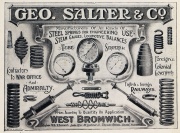George Salter and Co
Salters of West Bromwich, Telephone: West Bromwich 0666 (4 lines). Telegraphic Address: "Salters, West Bromwich". (1937)
See Product Images
1760 The brothers Richard and William Salter established businesses manufacturing springs and pocket steelyards (spring balances) in a cottage in Bilston.
1769 Company established.
1770 The company moved to West Bromwich, where it was one of the leading employers for more than 200 years.
1790s On Richard Salter's death, the business taken over by William's sons, John and George Salter, who also made bayonets.
1824 John Salter died and the firm took the name of George Salter, by which it is best known.
1825 John Salter's nephew George took over the firm, and the name became George Salter and Co.
1838 George Salter took out the first of many weighing equipment patents, which related to various ways of indicating weight on a spring balance that are still used today.
1849 When George Salter died, ownership of the firm remained within the family. It now made a wide variety of spring balances, vertical roasting jacks, musket bayonets, domestic weighing apparatus, steam pressure gauges and sad irons.
1879 The Salter Cricket Club formed a football team called WB Strollers, which later became West Bromwich Albion FC. The team which won the English FA Cup in 1886 included seven Salter employees.
1880s The product portfolio now including the first coin-operated public weighing machines as well as various food processing equipment, clothes washers, letter-clips, hat hooks and dynamometers. A factory was also opened in Berlin, in association with German firm Ubrig, which led to the development of automatic rotating display and vending machines.
1884 The Salter trademark, showing a Staffordshire knot pierced by an arrow, was registered and used on all the balances. It was also adopted by West Bromwich Albion Football Club, becoming the first commercial advertising on football shirts.
1890s Salter spring balances officially approved for trade use.
1895 Salter produced the first English typewriter - the British Empire.
1900 July. The Paris Exhibition. Springs of all strengths. Description of the wide range shown. [1]
1914 Specialities: spring balances, steel springs, automatic machines, pressure gauges, typewriters, testing machines, sad irons, box irons, gas irons, household machines etc. Employees 1250. [2]
WWI The manufacture of typewriters was suspended during the War.
1915 Salter became a limited company.
1917 The last George Salter died and the company passed to relatives from the Bache family.
1920s Salter now employed more than 1,000 people. A repair company was opened in Australia.
1936 The rights to the typewriter business were sold.
1936 Salter opened a new five storey factory - the highest building in West Bromwich. A second block was completed in 1940.
1937 Manufacturers of weighing and testing machines. [3]
1937 British Industries Fair Advert for: Spring Balances; Weighing Machines; Automatic and Testing Machines; Ironmongery; Springs, etc. (Hardware, Ironmongery and Brassfoundry / Farm and Garden Equipment Section - Stand Nos. A.507 and A.404). [4]
1939 See Aircraft Industry Suppliers
WWII. During the war, the company manufactured more than 750 million springs for war purposes. Also manufactured parts for the De Havilland Mosquito. [5]
1953 Public company incorporated because of payment of death duties and high taxation; most shares were held by the Bache family[6].
1961 Own 27 retail shops throughout West Bromwich, Manufacturers of spring balances and weighing machines, springs, retainers and fasteners, roller bearings, castings and "Salterpail" pre-packing service. 1,600 employees. [7]
1963 Motor Show exhibitor. Springs, roller bearings and castings. [8]
1973 George Salter and Co limited was bought by Staveley Industries, which also bought the Weigh-Tronix company of America, and other weighing businesses.
1998 The weighing businesses de-merged to become the Weigh-Tronix Corporation.
2002 Salter Housewares was bought out by its management.
2004 Company was sold again to HoMedics Company, a US based company.
See Also
Sources of Information
- ↑ The Engineer of 6th July 1900 p2
- ↑ 1914 Whitakers Red Book
- ↑ 1937 The Aeroplane Directory of the Aviation and Allied Industries
- ↑ 1937 British Industries Fair Advert p516; and p409
- ↑ Mosquito by C. Martin Sharp and Michael J. F. Bowyer. Published by Crecy Books in 1995. ISBN 0-947554-41-6
- ↑ The Times, Nov 18, 1953
- ↑ 1961 Dun and Bradstreet KBE
- ↑ 1963 Motor Show
- [1] Avery Weigh-Tronix Web Site
- Trademarked. A History of Well-Known Brands - from Aertex to Wright's Coal Tar by David Newton. Pub: Sutton Publishing 2008 ISBN 978-0-7509-4590-5























































